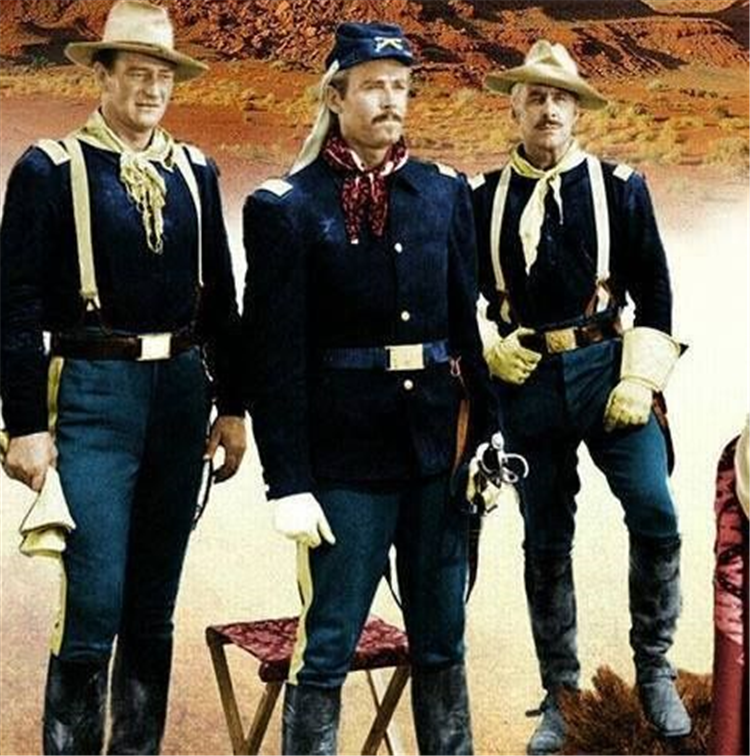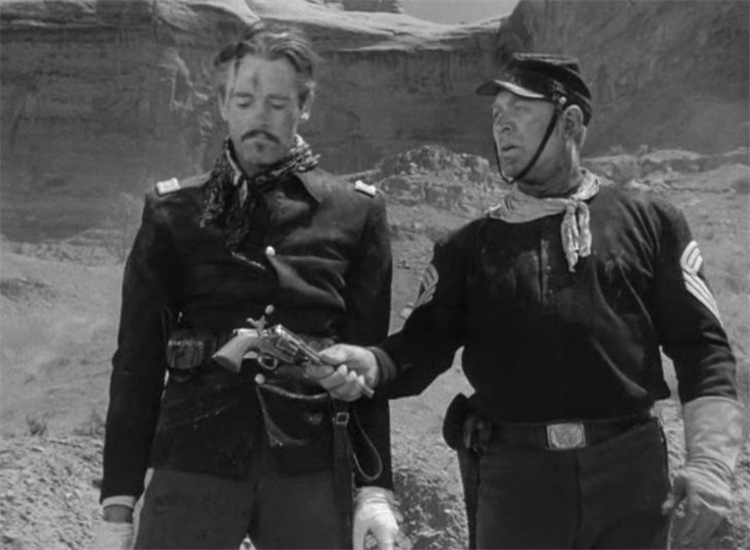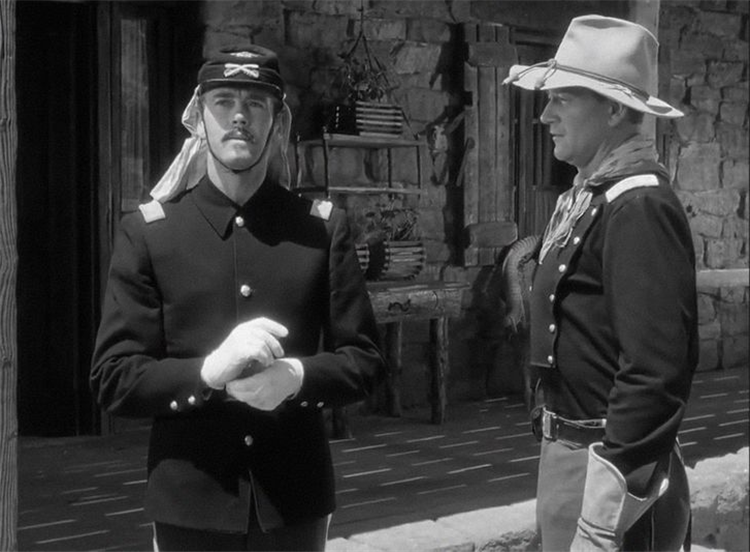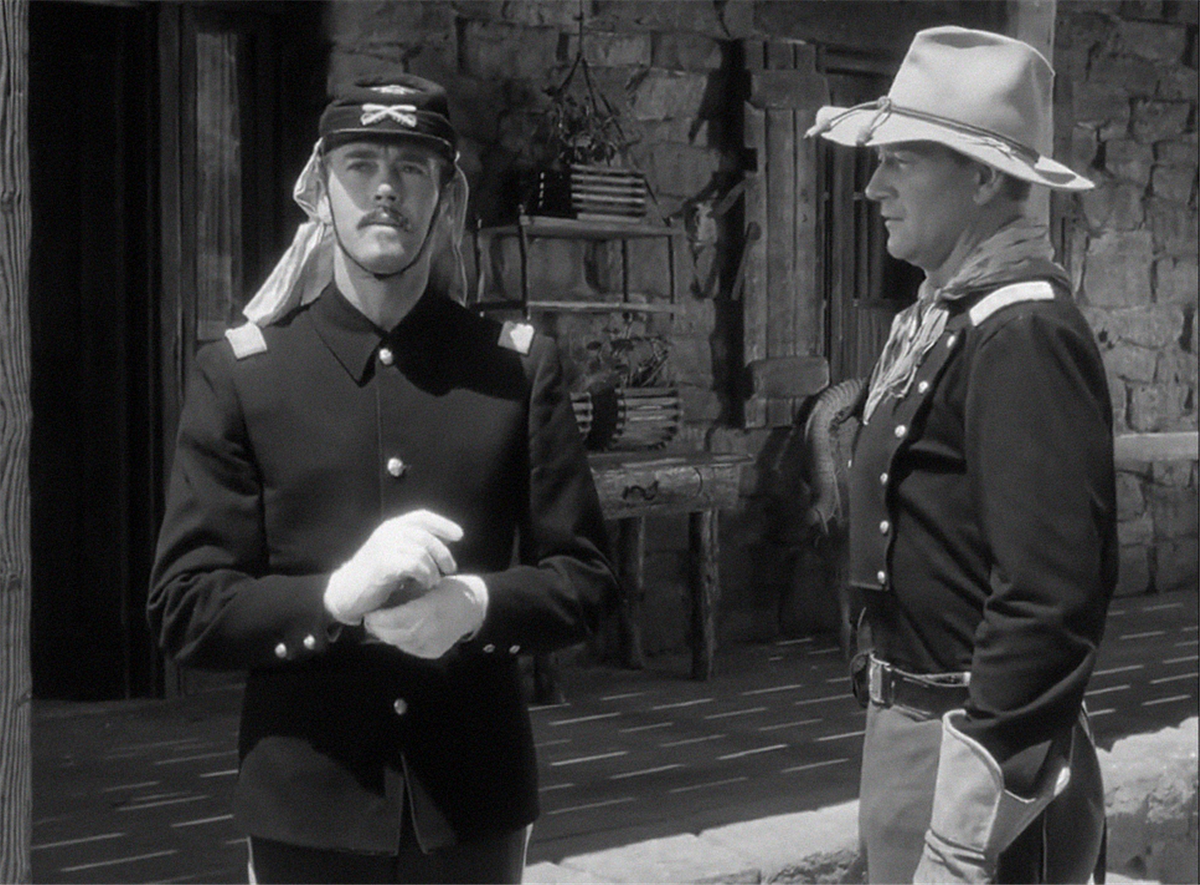Fort Apache starring John Wayne and Henry Fonda is the first film in what became John Ford’s ‘Cavalry’ trilogy. It’s one of John Ford’s most balanced, racially sensitive westerns that tries to understand the Native American issue even as it pays homage to the Army
Who better than an Irishman can understand the Indians, while still being stirred by tales of the US cavalry?
John Ford
Fort Apache(1948) begins with the shot of a Cavalry bugler framed against the horizon. The title scenes that follows shows inter-cut sequences of the following: a U.S. cavalry march, a band of Apache warriors going in to battle, a group of men and women performing the ceremonial ‘St. Patrick Day’s Grand March’ dance, Panoramic shots of Monument valley,…….etc. From these scenes alone, one can safely assume that this is a John Ford film. This was the first in the series of Ford’s Cavalry trilogy. It is more ambitious and complex than his earlier Western masterpiece, Stagecoach(1939), which practically launched or re-launched ‘the western’ as an A list genre; and, like “Stagecoach, this film is a social Allegory and a political allegory, where Ford expands on the earlier themes of nation building and Civilizing the West to make a bigger socio-political statement regarding Race, class, War and peace.

John Wayne and Henry Fonda are the two lead stars who have made maximum number of films with Ford. Both are a study in contrast with regards to their screen image, real-life image and acting styles; Fonda is the star of Young Mr. Lincoln, My Darling Clementine, Grapes of Wrath etc. where he plays the most dignified, honorable, vulnerable characters. Off screen, he was a liberal Democrat as opposed to Wayne- whom Ford launched to stardom in Stagecoach, and was a conservative republican. On screen, Wayne was the epitome of aggressive masculinity, courage, leadership and individualism. In Fort Apache, Ford brings these stars together in a quasi revisionist western, where he subverts a lot of myths and concepts that existed at the time, both about the American old- west as well as the genre of movie “western” itself. John Ford’s biggest act of subversion here is to cast his macho-star, John Wayne, as a pacifist: the peacemaker who understands the Apaches, and treats them as fellow man. In stark contrast , he casts Fonda as a class conscious ,racist, delusional war monger who believes the only solution for the Native American problem is through military action. Wayne plays Captain Kirby York, who is a veteran in dealing with Apaches and who was expected to take command of Fort Apache. But instead , Col. Owen Thursday, played by Henry Fonda, is selected for command. Thursday is an egocentric officer who deludes himself to be a leader in the vein of Genghis Khan and Alexander the Great. He believes fully in the absolutism of military authority and chain of command, no matter what the circumstances. His regular refrain ‘Any Questions?’ is basically a statement that orders are to be followed without questioning.

In many ways, the titular Fort Apache represents America: a desert island, distant from the main hub of civilization, where people came seeking riches and glory. The film begins with Col. Thursday and his daughter arriving at the Fort after an arduous journey. When they arrive, the inhabitants of the fort are celebrating the birthday of George Washington with a ceremonial dance. John Wayne gets the most subdued and perhaps the most ‘non-macho’ introduction of his career: he is seen wisecracking and dancing with the ladies. The scene gives the essence of Kirby York, the man and the soldier: who is happy in himself and his surroundings; his fellow soldiers love him and the dance routine is an attempt by him and his men to re-create the semblance of a civilized society in this frontier wilderness that they find themselves in. Once Thursday arrives, he goes about changing the existing order. He imposes his own ideas of discipline, rules and regulations on the fort, which he believes is the true army way. Though he is a reluctant traveler to this faraway land, he is determined to use the opportunity to mine everlasting glory; something very similar was done by the white European settlers after arriving in the new world. imposing their own culture and ideas on the indigenous population, even as they plundered the land for riches. Wayne and Co. who are already inhabitants of the Fort lives in communion with the natives and are well versed in their ways. Thursday, ‘The outsider”, who has no idea how to command a frontier regiment or deal with the native population, enforces some preset military rules and battle tactics which has no relevance in this place, but he is so full of himself, with a chip on his shoulder for being a west point graduate, that he refuses to see or is incapable of seeing the uselessness of his methods.
It’s inevitable that both the captain and colonel are going to be at loggerheads throughout the film. These two characters not only represent the two set of ideologies prevalent in both military and political establishment – the Dove and the Hawk- but also two kinds of human beings: One who is a realist; willing to adapt according to the surroundings; who will change with the changing times and survive, while the other who remains rooted in his ideology and is swept aside, unable to withstand the changes that happen with time. That’s exactly how their fates will end up at the conclusion of the movie, with Wayne’s Captain still standing while Fonda’s colonel is decimated along with his regiment.

The film is perhaps the first American mainstream movie where there is a sympathetic portrayal of the American natives. The main point of conflict in the film is regarding a band of Apaches who have walked off the reservation under their leader “Cochise”. They are engaged in battle with the U.S. Government and Thursday’s immediate task is to deal with them. It would be hard for a lot of people (who has a certain perception of John Wayne, especially after the resurfacing of his 1971 playboy interview) to believe that he was perhaps the first big time movie star to essay a character that spoke for the Native American rights. Wayne’s Captain York wants the Apaches to be treated with honor. He wants to seek a peaceful solution to their problems. He condemns the Indian League in Washington for its corruption in no uncertain terms. He treats the corrupt Indian agent. Meechum, with disdain, as he is mainly responsible for Indians leaving the reservation and going to war. Thursday realizes Meechum’s crimes, but as someone who follows the Military rules to the T, He gives him protection as he is part of the U.S. Government. Moreover, he considers Apaches as a tribe of murdering savages, who are unskilled in warfare and could be easily taken care in battle.

Apart from critiquing American government’s insensitivity towards the Native tribes, Ford also points his camera inward, into the American society, where class divisions are rampant. Col. Thursday is as virulently class conscious as he is racist. He forbids his daughter from getting married to the Second Lieutenant O’Rourke, because he is the son of a lowly Sergeant Major. Ford entwines images of war with images of civil society showing how interconnected one is to the other.. There are two major battle scenes and two ritualized ceremonial dance sequences. The ritualized nature of the ceremonial dance is strikingly similar to ritualized nature of cavalry movement in battle. Both dance sequences are interrupted with someone coming from outside. The first one is interrupted by the arrival of Col. Thursday. The second, ‘The Grand march scene’, is interrupted when York comes back successfully from his peace mission to the Apaches. But he soon realizes that Thursday has used him as bait to draw the Apaches out and that he plans to attack them. Wayne is shocked by this betrayal, but his words “I gave that man my word and nobody is going to make a liar out of me


